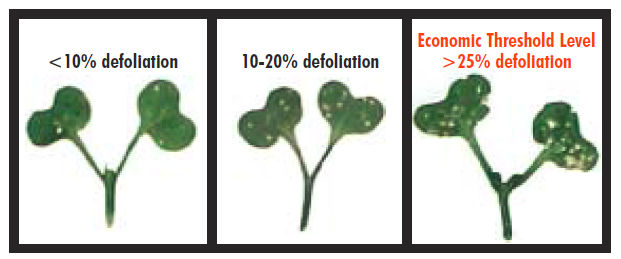Flea Beetles in Canola Production
May 16, 2016
Reducing flea beetle damage in canola and economic impact.
Agronomic practices that promote good stand establishment and rapid seedling growth will reduce the impact of flea beetles on canola yield. Seed size can also make a difference as seedlings from larger seeds are more vigorous and tolerant to flea beetle damage.
Reduced tillage and planting into stubble can provide a microclimate that is cooler, moister and less favorable to flea beetles. However, this can also slow canola emergence if soil temperatures are below 50 degrees Fahrenheit. Increasing seeding rates can help reduce the impact of flea beetle damage by spreading the feeding damage over more plants.
Seed treatments are the best way to protect young canola plants. Flea beetles need to ingest treated plants in order to take in the pesticide, so some feeding is necessary. Seed treatments are effective for 21-28 days, depending on weather and soil conditions. Planting canola into warm soil (temperatures above 50 degrees Fahrenheit) improves emergence and the plants’, ability to utilize the seed treatment during critical early growth stages.
Know your enemy: treatment starts with flea beetle identification.
Most flea beetles found in the United States are of the crucifer species. However, the striped flea beetle population is on the rise. To provide effective treatment, it is important to be able to identify both.
The adult crucifer flea beetle is a small oval-shaped, blackish beetle with a bright blue sheen on the elytra. It measures about 1/32 to 1/8 inches in length. The striped flea beetle is similar in size and shape, but they are black with two yellow strips on their wing covers.

The two species have a couple important differences between the two when it comes to management. Striped flea beetle adults emerge first in the spring, one to four weeks earlier than crucifer adults. Peak emergence of crucifer flea beetles occurs when ground temperatures reach 59 degrees Fahrenheit. In addition, striped flea beetles can be more tolerant of insecticides than crucifer flea beetles.
Field scouting for flea beetles is important.
Flea beetles over-winter as adults, so high populations in the fall are a good indicator of expected flea beetle activity in the spring.
- Field scouting for flea beetles should begin in newly emerged canola fields. Typically during late April, May or June when temperatures reach 57 degrees Fahrenheit.
- Access canola fields for flea beetles and feeding damage until plants have reached the 4-leaf stage. At this stage the canola plant is established and can outgrow the feeding damage.
- Flea beetles are most active during sunny, warm, calm and dry conditions. If possible, monitor daily at these times, as pest populations can increase rapidly.
- Cool, damp weather slows flea beetle activity, but they will continue to survive very well.
- The amount of defoliation on canola plants should be used as a guide to determine the need for a management.
Making the decision for flea beetle control.
The decision to treat infected crops with a foliar insecticide is based on an economic threshold. It should take into account these factors.
Level of flea beetle damage – The economic threshold for a foliar application is reached when 25% (on average) of the surface area of cotyledons and first true leaves have been injured and flea beetles are present.

Plant stands – Economic threshold is based on a stand of 7 to 14 plants per square foot. Growers may want to reduce their threshold levels when they have thinner stands because they can’t afford to lose plants.
Location of feeding – Leaves are the feeding site of choice, but cool conditions force flea beetles to move down and feed on stems. It takes only a little of this feeding to be fatal to seedlings, so action may be required even if leaf defoliation is less than 25%.
Newest leaves – if the newest leaves are growing fast and virtually untouched then spraying might not be necessary, even if cotyledons sustain heavy damage. However, if newest leaves reach 25% defoliation then spraying is warranted.
Crop stage – After the 4-leaf stage, canola plants are established and can outgrow flea beetle feeding without economic loss. However, if the crop is uneven, keep scouting until most of the crop has passed the 4-leaf stage.
Summary: Growers must be aware and monitor flea beetle populations as we start the growing season. If you need a foliar insecticide, there are many choices. But don’t wait for flea beetles to become a problem. Contact your local retailer early to discuss your situation and options.
Sources:
“Are Those Flea Beetles Worth Spraying” – Canola Council of Canada – Greg Sekulic, et al.
“Flea Beetles” – Canola Council of Canada – Canola Encyclopedia